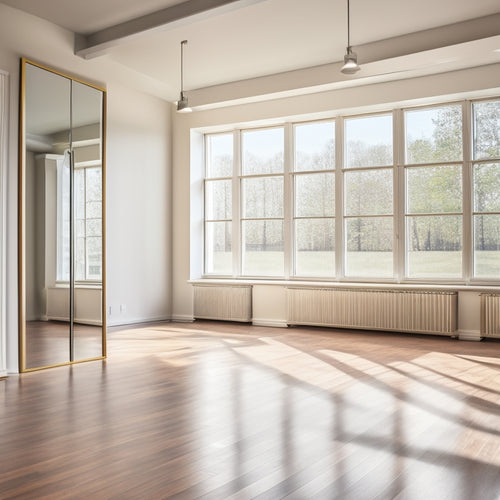
How High Should a Ballet Bar Be off the Ground?
Share
When setting up a ballet bar, your height and age are key factors to take into account. If you're under 5'2' or a young dancer, a lower bar is usually best. As you grow, your flexibility and range of motion change, impacting your ideal bar height. For beginners, a comfortable bar height allows for relaxed arm positioning and promotes proper posture. Customizing the bar height to your body type is also essential - measure from the floor to your wrist crease to find your perfect height. Now that you have a starting point, explore how studio style, class type, and more can fine-tune your bar height for top performance.
Key Takeaways
• Ideal ballet bar height is influenced by factors such as age, height, flexibility, and dance style, requiring a personalized approach.
• For beginners, a comfortable bar height allows for relaxed arm positioning, promoting proper posture, core engagement, and confidence.
• Dancers with longer legs may require a higher bar, while those with shorter legs may need a lower one, depending on their body proportions.
• Measuring from the floor to the wrist crease provides a personalized bar height, considering factors like flexibility range and body type.
• The perfect bar height enables balance, alignment, and control, allowing dancers to focus on technique without strain or discomfort.
Dancer's Height and Age Matter
As a dancer, your height and age significantly influence the ideal ballet bar height, with younger dancers and those under 5'2' typically requiring a lower bar. This is because flexibility ranges vary greatly depending on your age and growth stage.
During growth spurts, your body undergoes rapid changes, affecting your overall flexibility and range of motion. A bar that's too high can put unnecessary strain on your joints, while one that's too low can limit your movement. Finding the sweet spot guarantees you can focus on perfecting your technique without compromising your body.
Studio Style and Class Type
Your studio's style and the type of class you're taking also play a significant role in determining the ideal ballet bar height. In commercial settings, bars might be lower to accommodate high-energy movements.
For Contemporary classes, a lower bar can facilitate more fluid, expressive movements. Conversely, studios with Historical influences may prefer taller bars to maintain traditional techniques.
In Recreational classes, a mid-range bar height can cater to a broader range of students. Consider the unique demands of your class type when adjusting the bar height. By doing so, you'll create an environment that supports your students' needs, allowing them to move freely and focus on their technique.
Barre Height for Beginners
When you're new to ballet, a barre height that allows you to stand comfortably with your arm relaxed by your side, with your elbow slightly bent, is ideal. This position enables you to maintain proper posture and engages your core, promoting good body awareness. As a beginner, it's crucial to focus on developing barre confidence, which starts with a comfortable and accessible barre height.
Here are some benefits of an ideal barre height for beginners:
- Allows for correct alignment and posture
- Enables you to engage your core and maintain balance
- Helps build confidence in your movements and shifts
- Fosters greater body awareness and control
Accommodating Different Body Types
You'll need to adjust the barre height to accommodate your individual body type, whether you're petite, tall, or somewhere in between, as a one-size-fits-all approach won't work for everyone.
Your body proportions play a significant role in determining the ideal barre height. For instance, dancers with longer legs in proportion to their torso may require a higher barre, while those with shorter legs may need it lower.
Additionally, your flexibility range also comes into play. If you have a greater range of motion, you may prefer a lower barre to allow for deeper movements. Conversely, those with limited flexibility may need a higher barre to maintain proper alignment.
Measuring for Ideal Barre Height
To determine the ideal barre height, measure the distance from the floor to the crease of your wrist when your arm is relaxed by your side. This will give you a personalized measurement that suits your body type.
-
Consider the barre material: wood, metal, or a combination of both, as it may affect the overall feel and grip.
-
Take note of the floor type: hardwood, carpet, or vinyl, as it may impact the barre's stability and traction.
-
Guarantee the barre is sturdy and securely attached to the wall or floor to avoid any accidents.
- Consider consulting with a dance instructor or fitness expert to get the perfect barre height tailored to your specific needs.
Frequently Asked Questions
Can I Use a Wall-Mounted Barre for Home Practice?
You can definitely use a wall-mounted barre for home practice, considering your home decor and personal preference for a sleek, space-saving design that provides freedom to move and practice ballet without constraints.
Are Adjustable Barres Better Than Fixed Ones?
As you ponder the perfect barre, you coincidentally stumble upon the ideal solution: adjustable barres, offering unparalleled portability benefits and customization options, allowing you to tailor the height to your needs, anywhere, anytime.
Can I Use a Barre for Other Dance Styles Besides Ballet?
You can definitely use a barre for styles beyond ballet, incorporating Contemporary fusion, Modern adaptation, Hip hop infusion, and Jazz integration into your practice, allowing you to explore new movements with freedom and expression.
Do I Need a Barre for Every Student in a Group Class?
You'll need an army of barres if you're planning a one-on-one student-to-barre ratio, but realistically, a 3-4 students per barre ratio is ideal, fostering healthy class dynamics and allowing for personalized attention without breaking the bank.
Are There Any Space-Saving Barre Options for Small Studios?
You'll find space-saving solutions for your small studio in compact designs and folding alternatives, allowing you to optimize your floor plan while maintaining functionality, giving you the freedom to focus on your students' progress.
Related Posts
-

Why Hip Hop Dancers Need Flawless Makeup Tutorials
You need a flawless makeup look that can keep up with your high-energy hip hop dance routines, emphasizing the import...
-

Benefits of Wearing Activity Trackers Daily
Wearing an activity tracker daily can transform your fitness routine. You'll gain understanding into your daily steps...
-

Tips and Tricks for Collapsible Ballet Bar Installation
To install your collapsible ballet bar, start by gathering essential tools like a drill, level, and measuring tape. M...


